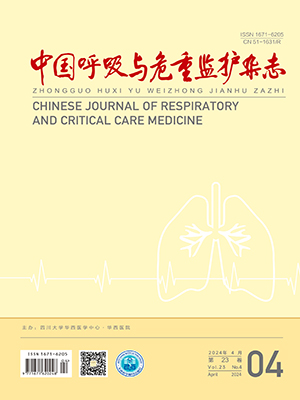| 1. |
Huang LX, Yao Q, Gu XY, et al. 1-year outcomes in hospital survivors with COVID-19: a longitudinal cohort study. Lancet, 2021, 398: 747-758.
|
| 2. |
Wu XJ, Liu XF, Zhou YL, et al. 3-month, 6-month, 9-month, and 12-month respiratory outcomes in patients following COVID-19-related hospitalisation: a prospective study. Lancet Respir Med, 2021, 9(7): 747-754.
|
| 3. |
Garg M, Maralakunte M, Garg S, et al. The conundrum of 'long-COVID-19': a narrative review. Int J Gen Med, 2021, 14: 2491-2506.
|
| 4. |
Cabrera Martimbianco AL, Pacheco RL, Bagattini ÂM, et al. Frequency, signs and symptoms, and criteria adopted for long COVID-19: a systematic review. Int J Clin Pract, 2021, 75: e14357.
|
| 5. |
张庆丰, 胡克. 新型冠状病毒肺炎患者的肺部后遗症. 中国呼吸与危重监护杂志, 2022, 21(7): 516-521.
|
| 6. |
中华人民共和国国家卫生健康委员会办公厅. 新型冠状病毒感染的肺炎诊疗方案(试行第八版)[EB/OL]. http://www.nhc.gov.cn/yzygj/s7653p/202104/7de0b3837c8b4606a0594aeb0105232b/files/f192ac6e5567469db4f0a8691ca18907.pdf.
|
| 7. |
中华医学会. 常规肺功能检查基层指南(2018年). 中华全科医师杂志, 2019, 18(6): 511-518.
|
| 8. |
Lee N, Hui D, Wu A, et al. A major outbreak of severe acute respiratory syndrome in Hong Kong. N Engl J Med, 2003, 348(20): 1986-1994.
|
| 9. |
Hsu HH, Tzao C, Wu CP, et al. Correlation of high-resolution CT, symptoms, and pulmonary function in patients during recovery from severe acute respiratory syndrome. Chest, 2004, 126(1): 149-158.
|
| 10. |
Lam MH, Wing YK, Yu MW, et al. Mental morbidities and chronic fatigue in severe acute respiratory syndrome survivors: long-term follow-up. Arch Intern Med, 2009, 169(22): 2142-2147.
|
| 11. |
Beretta S, Cristillo V, Camera G, et al. Incidence and long-term functional outcome of neurologic disorders in hospitalized COVID-19 patients infected with Pre-Omicron variants. Neurology, 2023, 29,101(9): e892-e903.
|
| 12. |
Jackson C, Stewart ID, Plekhanova T, et al. Effects of sleep disturbance on dyspnoea and impaired lung function following hospital admission due to COVID-19 in the UK: a prospective multicentre cohort study. Lancet Respir Med, 2023, 11(8): 673-684.
|
| 13. |
Peter RS, Nieters A, Kräusslich HG, et al. Post-acute sequelae of covid-19 six to 12 months after infection: population based study. BMJ, 2022, 379: e071050.
|
| 14. |
Xie Y, Xu E, Bowe B, et al. Long-term cardiovascular outcomes of COVID-19. Nat Med, 2022, 28(3): 583-590.
|
| 15. |
Paul BD, Lemle MD, Komaroff AL et al. Redox imbalance links COVID-19 and myalgic encephalomyelitis/chronic fatigue syndrome. Proc Natl Acad Sci U S A, 2021, 118(34): e2024358118.
|
| 16. |
Taquet M, Sillett R, Zhu L, et al. Neurological and psychiatric risk trajectories after SARS-CoV-2 infection: an analysis of 2-year retrospective cohort studies including 1284437 patients. Lancet Psychiatry, 2022, 9(10): 815-827.
|
| 17. |
Balcom EF, Nath A, Power C. Acute and chronic neurological disorders in COVID-19: potential mechanisms of disease. Brain, 2021, 144(12): 3576-3588.
|
| 18. |
Ferrucci R, Dini M, Groppo E, et al. Long-lasting cognitive abnormalities after COVID-19. Brain Sci, 2021, 11(2): 235.
|
| 19. |
Beretta S, Iannuzzi F, Diamanti S, et al. Neurovascular and infectious disease phenotype of acute stroke patients with and without COVID-19. Neurol Sci, 2022, 43(8): 4619-4625.
|
| 20. |
Ballouz T, Menges D, Anagnostopoulos A, et al. Recovery and symptom trajectories up to two years after SARS-CoV-2 infection: population based, longitudinal cohort study. BMJ, 2023, 381: e074425.
|
| 21. |
Carfì A, Bernabei R, Landi F, et al. Persistent symptoms in patients after acute COVID-19. JAMA, 2020, 324: 603-605.
|
| 22. |
耿茜, 郑劲平, 梁晓林, 等. 新型冠状病毒肺炎患者康复初期肺功能及心肺运动功能评价. 中国呼吸与危重监护杂志, 2021, 20(5): 320-324.
|
| 23. |
Aly Z, Xie Y, Bowe B. High-dimensional characterization of post-acute sequelae of COVID-19. Nature, 2021, 594(7862): 259-264.
|
| 24. |
Ong KC, Ng AW, Lee LS, et al. 1-year pulmonary function and health status in survivors of severe acute respiratory syndrome. Chest, 2005, 128: 1393-1400.
|
| 25. |
刘羽翔, 叶艳平, 张萍, 等. SARS患者3年康复期肺功能变化的临床研究. 中国危重病急救医学, 2007, 19(9): 536-538.
|
| 26. |
Yan ZP, Yang M, Lai CL. Long COVID-19 syndrome: a comprehensive review of its effect on various organ systems and recommendation on rehabilitation plans. Biomedicines, 2021, 9(8): 966.
|
| 27. |
Wiemken TL, McGrath LJ, Andersen KM, et al. Coronavirus disease 2019 severity and risk of subsequent cardiovascular events. Clin Infect Dis, 2023, 76(3): e42-e50.
|
| 28. |
Puntmann VO, Carerj ML, Wieters I, et al. Outcomes of cardiovascular magnetic resonance imaging in patients recently recovered from coronavirus disease 2019 (COVID-19). JAMA Cardiol, 2020, 5(11): 1265-1273.
|
| 29. |
Huang L, Zhao PJ, Tang DZ, et al. Cardiac involvement in patients recovered from COVID-2019 identified using magnetic resonance imaging. JACC Cardiovasc Imaging, 2020, 13(11): 2330-2339.
|
| 30. |
Wu YJ, Guo C, Tang LT, et al. Prolonged presence of SARS-CoV-2 viral RNA in faecal samples. Lancet Gastroenterol Hepatol, 2020, 5(5): 434-435.
|
| 31. |
Kariyawasam JC, Jayarajah U, Riza R, et al. Gastrointestinal manifestations in COVID-19. Trans R Soc Trop Med Hyg, 2021, 115: 1362-1388.
|
| 32. |
Cheung KS, Hung IFN, Chan PPY, et al. Gastrointestinal manifestations of SARS-CoV-2 infection and virus load in fecal samples from a Hong Kong cohort: Systematic Review and Meta-analysis. Gastroenterology, 2020, 159(1): 81-95.
|




